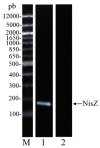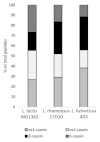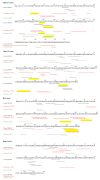Antimicrobial Potential of Food Lactic Acid Bacteria: Bioactive Peptide Decrypting from Caseins and Bacteriocin Production
- PMID: 33383704
- PMCID: PMC7824078
- DOI: 10.3390/microorganisms9010065
Antimicrobial Potential of Food Lactic Acid Bacteria: Bioactive Peptide Decrypting from Caseins and Bacteriocin Production
Abstract
Lactic acid bacteria (LAB) potential in the food industry and in the biotechnological sector is a well-established interest. LAB potential in counteracting especially food-borne infections has received growing attention, but despite being a road full of promises is yet poorly explored. Furthermore, the ability of LAB to produce antimicrobial compounds, both by ribosomal synthesis and by decrypting them from proteins, is of high value when considering the growing impact of multidrug resistant strains. The antimicrobial potential of 14 food-derived lactic acid bacteria strains has been investigated in this study. Among them, four strains were able to counteract Listeria monocytogenes growth: Lactococcus lactis SN12 and L. lactis SN17 by high lactic acid production, whereas L. lactis 41FLL3 and Lactobacillus sakei I151 by Nisin Z and Sakacin P production, respectively. Strains Lactococcus lactis MG1363, Lactobacillus rhamnosus 17D10 and Lactobacillus helveticus 4D5 were tested and selected for their potential attitude to hydrolyze caseins. All the strains were able to release bioactive peptides with already known antimicrobial, antihypertensive and opioid activities. These features render these strains or their bioactive molecules suitable for use in food as biocontrol agents, or as nutraceutical supplements to treat mild disorders such as moderate hypertension and children insomnia. These results highlight once again that LAB potential in ensuring food safety, food nutraceutical value and ultimately in favoring human health is still underexplored and underexploited.
Keywords: Lactobacillus helveticus 4D5; Lactobacillus rhamnosus 17D10; Lactococcus lactis; Nisin Z. Lactobacillus sakei I151; Sakacin; antimicrobial peptides; casein; lactic acid; mass spectrometry.
Conflict of interest statement
The authors declare no conflict of interest.
Figures




Similar articles
-
Use of Potential Probiotic Lactic Acid Bacteria (LAB) Biofilms for the Control of Listeria monocytogenes, Salmonella Typhimurium, and Escherichia coli O157:H7 Biofilms Formation.Front Microbiol. 2016 Jun 10;7:863. doi: 10.3389/fmicb.2016.00863. eCollection 2016. Front Microbiol. 2016. PMID: 27375584 Free PMC article.
-
Potential of lactic acid bacteria isolated from specific natural niches in food production and preservation.Int J Food Microbiol. 2006 Dec 1;112(3):230-5. doi: 10.1016/j.ijfoodmicro.2006.04.009. Epub 2006 Jun 9. Int J Food Microbiol. 2006. PMID: 16764959
-
Donkey Milk Fermentation by Lactococcus lactis subsp. cremoris and Lactobacillus rhamnosus Affects the Antiviral and Antibacterial Milk Properties.Molecules. 2021 Aug 23;26(16):5100. doi: 10.3390/molecules26165100. Molecules. 2021. PMID: 34443691 Free PMC article.
-
Antibacterial activity of selected standard strains of lactic acid bacteria producing bacteriocins--pilot study.Postepy Hig Med Dosw (Online). 2012 Oct 25;66:787-94. doi: 10.5604/17322693.1015531. Postepy Hig Med Dosw (Online). 2012. PMID: 23175332 Review.
-
Engineering of lactic acid bacteria for delivery of therapeutic proteins and peptides.Appl Microbiol Biotechnol. 2019 Mar;103(5):2053-2066. doi: 10.1007/s00253-019-09628-y. Epub 2019 Jan 17. Appl Microbiol Biotechnol. 2019. PMID: 30656391 Review.
Cited by
-
Role of Exposure to Lactic Acid Bacteria from Foods of Animal Origin in Human Health.Foods. 2021 Sep 4;10(9):2092. doi: 10.3390/foods10092092. Foods. 2021. PMID: 34574202 Free PMC article. Review.
-
Phylogenetic comparative analysis: Chemical and biological features of caseins (alpha-S-1, alpha-S-2, beta- and kappa-) in domestic dairy animals.Front Vet Sci. 2022 Sep 15;9:952319. doi: 10.3389/fvets.2022.952319. eCollection 2022. Front Vet Sci. 2022. PMID: 36187819 Free PMC article.
-
Stability and Activity of the Antimicrobial Peptide Leg1 in Solution and on Meat and Its Optimized Generation from Chickpea Storage Protein.Foods. 2021 May 25;10(6):1192. doi: 10.3390/foods10061192. Foods. 2021. PMID: 34070446 Free PMC article.
-
Functional bacterial cultures for dairy applications: Towards improving safety, quality, nutritional and health benefit aspects.J Appl Microbiol. 2022 Jul;133(1):212-229. doi: 10.1111/jam.15510. Epub 2022 Mar 15. J Appl Microbiol. 2022. PMID: 35238463 Free PMC article. Review.
-
Causal relationship between the gut microbiota and insomnia: a two-sample Mendelian randomization study.Front Cell Infect Microbiol. 2024 Mar 4;14:1279218. doi: 10.3389/fcimb.2024.1279218. eCollection 2024. Front Cell Infect Microbiol. 2024. PMID: 38500501 Free PMC article.
References
-
- Quinto E.J., Jiménez P., Caro I., Tejero J., Mateo J., Girbés T. Probiotic Lactic Acid Bacteria: A Review. Food Nutr. Sci. 2014;5:1765–1775. doi: 10.4236/fns.2014.518190. - DOI
LinkOut - more resources
Full Text Sources
Molecular Biology Databases
Miscellaneous

